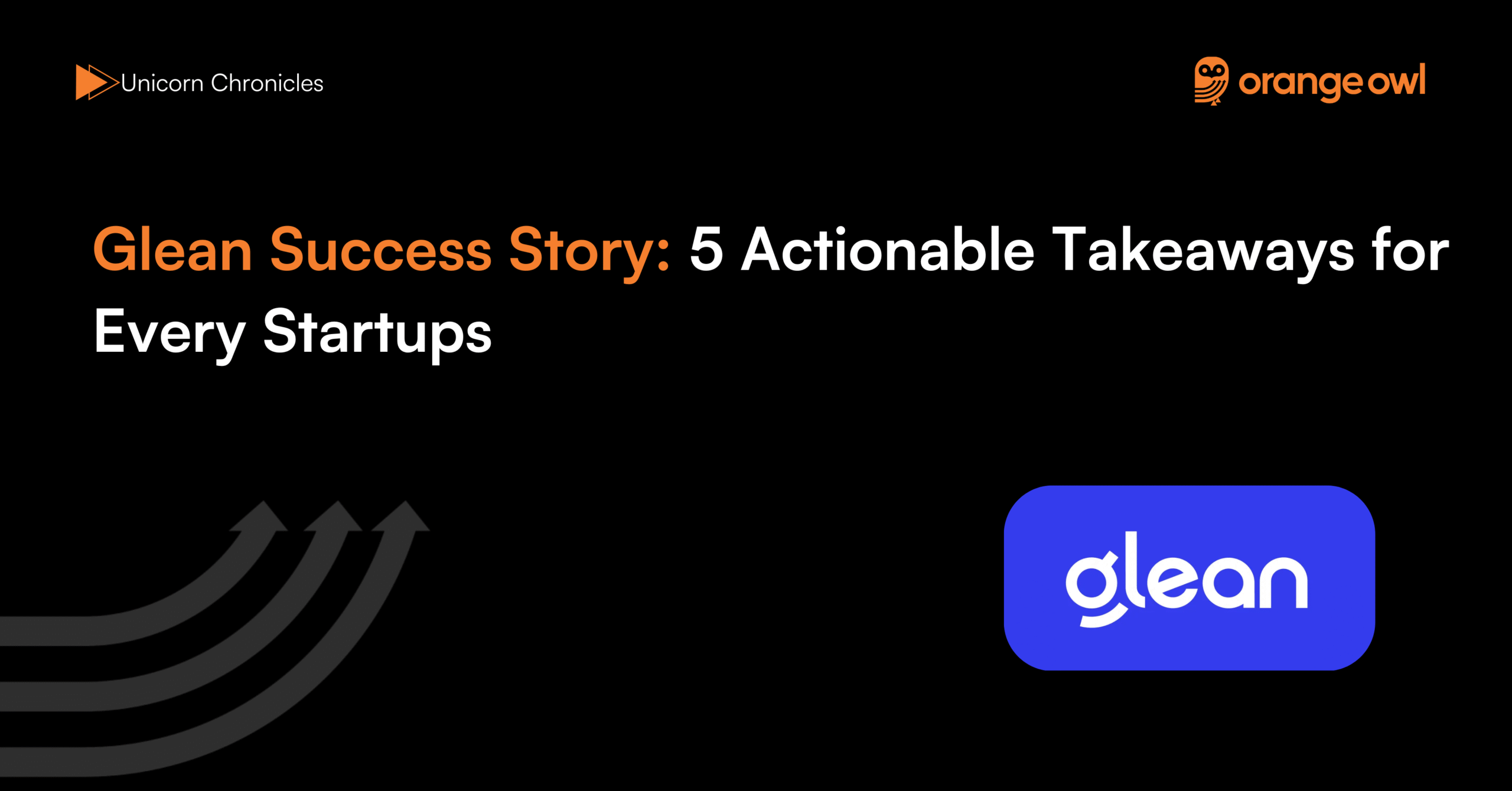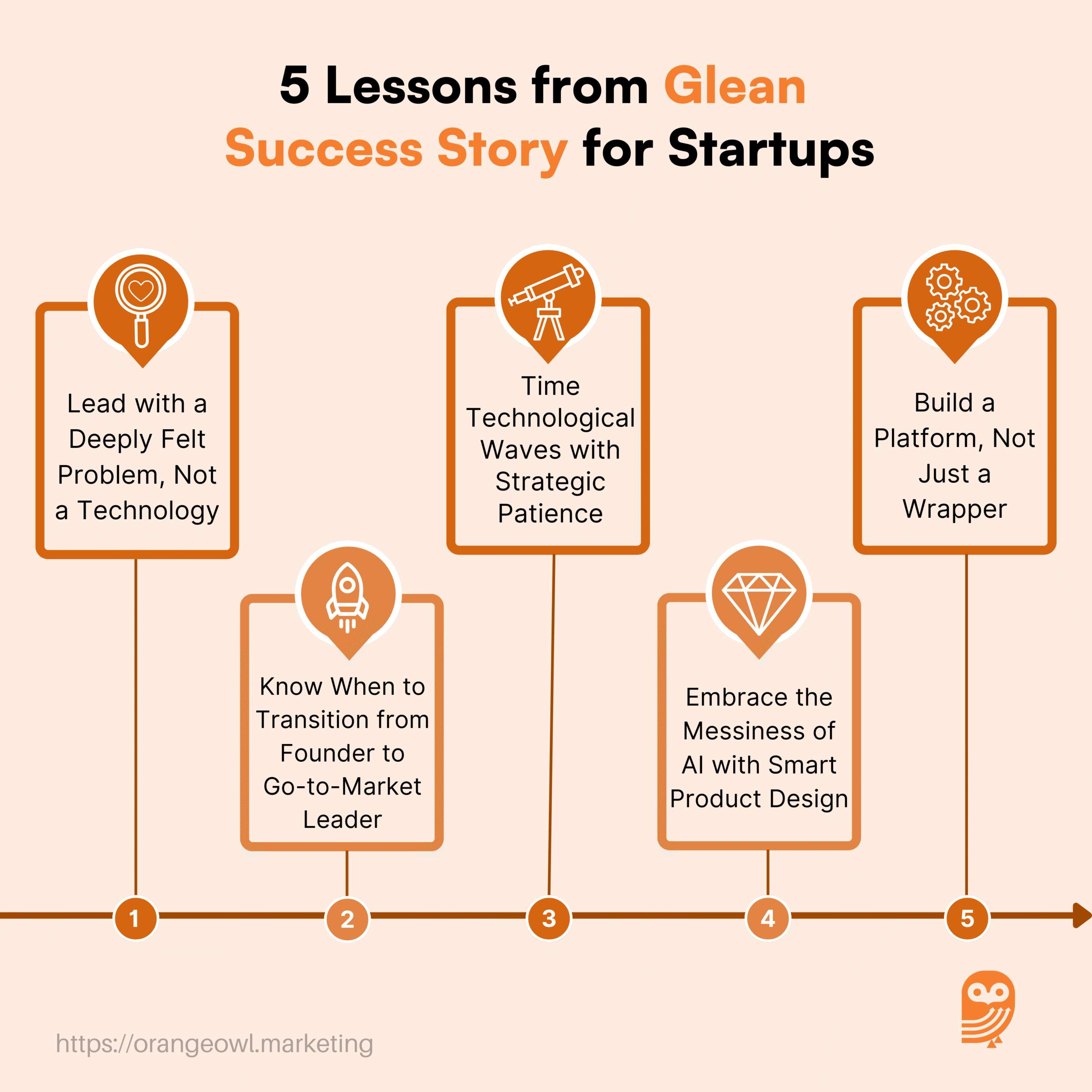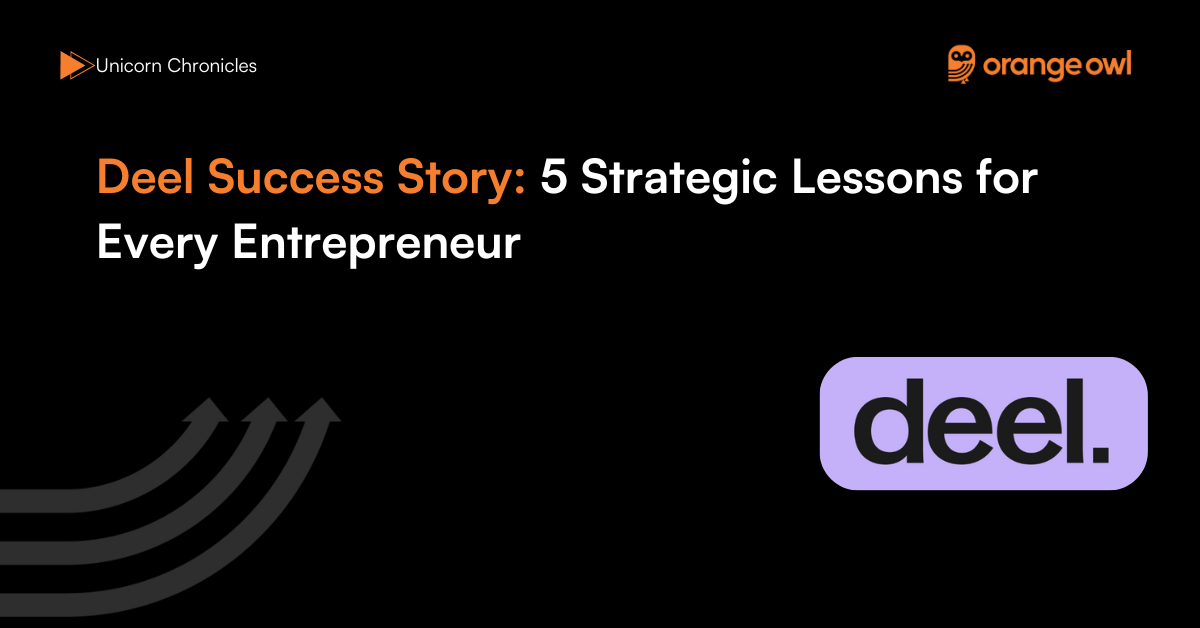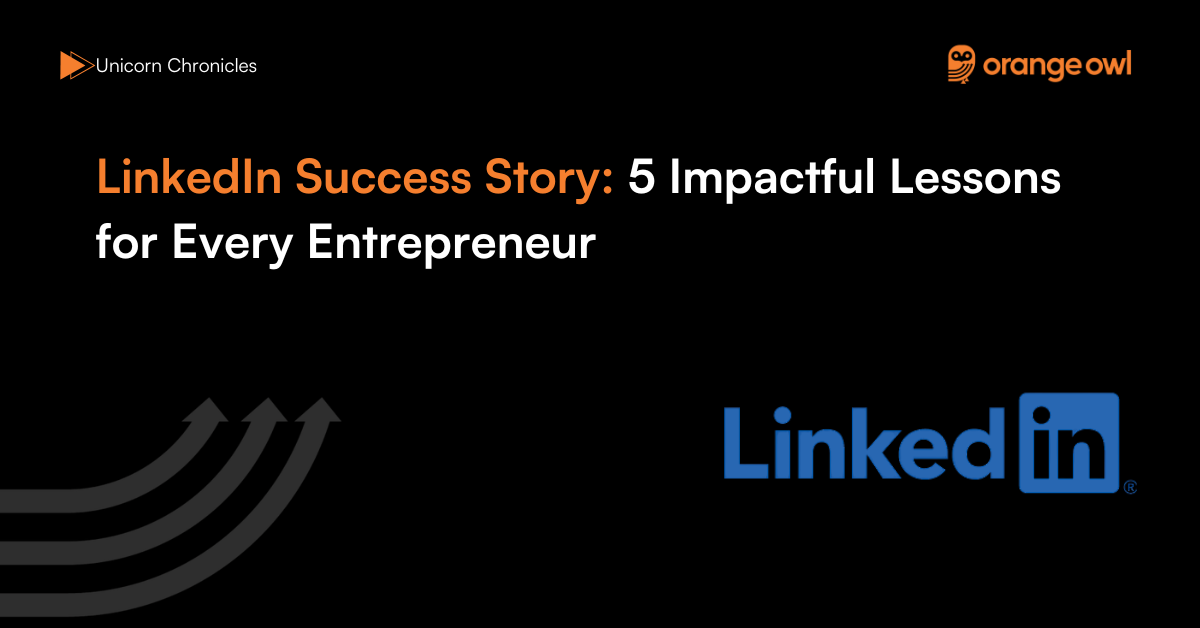Glean Success Story: 5 Actionable Takeaways for Every Startups
Vivek Goel
August 30, 2025

Table of Contents
Introduction: A Startup’s Journey to Solve an Age-Old Problem
In the competitive world of enterprise software, few challenges have remained as stubbornly unsolved as internal knowledge discovery. For decades, employees have wasted countless hours searching for information scattered across dozens of applications, a universal pain point that directly impacts productivity and innovation. This case study explores the journey of Glean, a groundbreaking AI startup founded in 2019 by seasoned entrepreneur Arvind Jain. Glean set out with a bold vision: to build a Google for the enterprise, empowering every knowledge worker with the information they need to do their best work. Its groundbreaking approach has not only attracted hundreds of enterprise customers like Canva and Databricks but also earned it prestigious recognition, including a coveted spot on the Forbes AI 50 list.
This document delves into Glean’s remarkable success story, tracing its path from a patient market creator to a definitive leader in the enterprise AI space. The company has raised over $360 million in funding, reached a $2.2 billion valuation, and grown to a team of several hundred employees, all while delivering significant ROI to customers, with users saving an average of 5 hours every week on information retrieval. We will analyze the company’s origins, the significant challenges it overcame, its multi-faceted growth strategies, and its unique marketing approach. The ultimate goal is to extract actionable
lessons and takeaways for every entrepreneur aiming to build an enduring, impactful technology company. Glean’s story is not just about a successful product; it’s a blueprint for navigating technological shifts, creating new markets, and building a company with a clear and compelling mission. As Arvind Jain, the founder and CEO, articulates the grand vision:
“Every employee should have their own team of AI agents to help them work smarter and achieve more.”
Origin Story
The genesis of every great startup can often be traced back to a founder’s deep-seated frustration with a specific problem. Arvind Jain’s journey to creating Glean is a quintessential example. His conviction was forged over more than a decade at Google, where he was instrumental in building the world’s most sophisticated search infrastructure. Despite being at the epicenter of information retrieval, he was acutely aware of a glaring paradox:
“It was incredibly hard to find anything inside Google as well when it came to our work.”
This firsthand experience planted the seed of an idea that would germinate years later.
After Google, Jain co-founded the enterprise data management company Rubrik, scaling it into a massive success. It was here, as a leader feeling the operational pains of a rapidly growing organization, that the problem became impossible to ignore. A company-wide pulse survey revealed that one of the biggest complaints from his own employees was that they cannot find anything. For Jain, this was the final catalyst. He felt a personal determination to fix this problem.
This origin story offers a powerful first lesson for any aspiring entrepreneur: the most compelling business ideas often come from solving a problem you have personally and deeply experienced. Jain didn’t need to conduct extensive market research to validate the pain point; he lived it. This gave him the unwavering conviction required to tackle a problem space that others had written off as impossible. He envisioned a platform that could unify a company’s fragmented knowledge, not just as a search tool, but as a comprehensive work AI platform designed to bring automation and efficiency to many business processes.
Business Landscape and Challenges
When Glean entered the market in 2019, it faced a landscape defined by skepticism and failure. The enterprise search market was a graveyard of failed attempts, a space that had never seen success. As a result, business leaders were conditioned to believe it was an unsolvable problem. This presented Glean with its first major challenge: it wasn’t just selling a product; it had to create a market. As Jain recounts, enterprise leaders didn’t really care about that much because they not seen great products in that area. This skepticism existed despite clear data showing that knowledge workers spend one-third of all employee time, just spent looking for information. Glean had to educate its customers and evangelize a new reality where instant access to company knowledge was possible.
The technical challenges were equally daunting. A core takeaway from Glean’s journey is its approach to the inherent unreliability of AI models. Unlike traditional deterministic software, Large Language Models (LLMs) are completely non-deterministic. Jain explains,
“you ask the same question five times you’re going to get five you know different responses.”
For an enterprise tool where accuracy and consistency are paramount, this was a massive hurdle. The engineering team had to invest heavily in building a sophisticated application architecture around the models to make them reliable, accurate, and useful for business-critical applications. This involved developing robust systems for retrieval (rag based AI application), ranking, and ensuring the quality of information presented to the user.
A further challenge was navigating the hype cycle following the ChatGPT moment happened. While this sudden market awareness was a huge tailwind, it also created the challenge of managing sky-high customer expectations. It became very easy to create super amazing demos that didn’t reflect the real-world performance of the technology. Jain and his team learned the hard way that overpromising could hurt them later. This led to a disciplined approach of setting realistic expectations with customers, focusing on building trust by ensuring the initial production experience was positive and value-driven, not a disappointment compared to a flashy demo. This journey provides a crucial case study for any AI startup on the importance of balancing visionary marketing with pragmatic, transparent communication about the technology’s current capabilities.
Growth Strategies – Glean Success Story
Glean’s growth trajectory offers a masterclass in strategic execution for a deep-tech startup. Its strategies evolved in distinct phases, reflecting a keen understanding of both technology readiness and market dynamics.
1. Technology-First Approach:
Glean’s entire existence is predicated on a forward-looking technological thesis. Jain founded the company by betting on the convergence of three critical trends that he believed would finally make enterprise search solvable.
- The Rise of SaaS: The shift to cloud-based applications with great apis was the first pillar. It meant a company’s knowledge was no longer locked in private data centers, making it programmatically accessible for the first time.
- Cloud & Open Source: The availability of powerful cloud infrastructure and core search Tech components becoming open source drastically reduced the immense R&D investment that would have been required in the past, making the problem tractable for a startup.
- The Transformer Model: This was the biggest one. Jain and his team, with their background at Google, saw the step function change these new language models offered in understanding information conceptually, well before the public craze around generative AI.
2. Patient Market Creation:
For its first in almost four years, Glean was in market creation mode. Instead of pursuing growth at all costs, the
startup focused on finding visionary leaders who are willing to take a chance on us. This involved a patient process of education and evangelism, proving the product’s value with early adopters and building a solid foundation of customer success stories.
3. Capitalizing on the AI Wave:
When the ChatGPT moment arrived, Glean was perfectly positioned. The market’s understanding of AI’s potential exploded overnight, and Glean was ready with a secure, enterprise-grade product. This external validation transformed Glean from a niche priority into a strategic imperative for businesses, dramatically accelerating its growth trajectory and solidifying its place on lists like the Forbes AI 50.
4. Horizontal Platform Strategy:
A key strategic choice was to build Glean as a broad, horizontal platform designed to add value for every employee in every business. While this is a more challenging path than targeting a specific vertical, the long-term vision is for Glean to become the core enterprise context layer. This platform can then serve up its understanding of a company’s knowledge, people, and processes to other vertical AI applications through APIs, making the entire ecosystem smarter and more integrated.
Marketing Strategy: A Story of Education and Empowerment
Glean’s marketing strategy offers valuable lessons in how a deep-tech startup can build a brand in a skeptical market. Unlike consumer apps that can rely on viral loops, Glean’s early approach was rooted in education, evangelism, and strategic storytelling.
Initially, the core challenge was communicating what Glean even was. The team first launched by calling the product a work assistant, but found that customers were terribly confused . This led to a crucial marketing takeaway: One must meet the market where it is. The team pragmatically repositioned the product as a search product to connect with a known, albeit unsolved, problem. This gave customers a familiar frame of reference. Only after the market’s understanding of AI matured could Glean successfully re-embrace the broader and more accurate AI assistant and platform messaging .
Another pillar of Glean’s marketing is a disciplined balance between a powerful vision and a grounded reality. The company sells an inspiring future where AI agents augment every worker. However, this is deliberately tempered with a focus on not overpromising in the sales process. Jain stresses the importance of training the sales team not to go and over promise, ensuring the customer’s first experience is positive. This builds the long-term trust necessary for enterprise relationships. These customer stories, often highlighting concrete metrics like the 5 hours saved per week, were far more powerful than any traditional advertisement. This is a key lesson for any entrepreneur in the B2B SaaS space.
5 Actionable takeaways for Every Entrepreneur
This success story is rich with actionable lessons and takeaways. Arvind Jain’s journey with Glean provides a powerful playbook for building a category-defining company.
1. Lead with a Deeply Felt Problem, Not a Technology:
Jain’s motivation was born from his personal and professional frustration with a universal problem. He advises every entrepreneur today to start with the problem that you’re trying to solve and to use AI as a tool. He explicitly warns against thinking of yourself as an AI founder, because the technology itself is not a sustainable differentiator. The real moat is built by applying technology to solve a meaningful business problem in a uniquely effective way.
2. Time Technological Waves with Strategic Patience:
Glean’s success was built on a bet on the convergence of SaaS, cloud computing, and Transformer models. However, Jain demonstrated strategic patience, spending four years in market creation mode before the AI wave crested. This takeaway is crucial: it’s not enough to be right about a technology shift; you must also have the patience and capital to survive until the market is ready for your solution.

3. Build a Platform, Not Just a Wrapper:
In an era where many fear being commoditized as a GPT wrapper, Jain provides a clear counter-argument. He stresses that most valuable business problems require you to do a lot more work than simply calling a model. Glean’s defensibility comes not from the LLM itself, but from the complex infrastructure around it: the data integrations, the security and permissions layer, the workflow automations, and the deep understanding of user context. The lesson here is that enduring value is created in the hard, unglamorous work of building a complete solution.
4. Know When to Transition from Founder to Go-to-Market Leader:
One of the most candid lessons Jain shares is about his own evolution as a leader. As a technical founder, he admits one of his biggest mistakes was being too conservative in terms of investing in our go to market. He learned that once product-market fit is established and customers are getting significant value, you have to be willing to “go big” and aggressively invest in sales and marketing. For any technical entrepreneur, this is a critical and often difficult mindset shift, but it is essential for capturing a market opportunity. His experience scaling Rubrik past a billion dollars in AR likely informed this lesson.
5. Embrace the Messiness of AI with Smart Product Design:
Jain is realistic about the limitations of today’s AI. He acknowledges that models are non-deterministic and imperfect. The takeaway is not to wait for perfect models, but to design products and user experiences that account for these limitations. This involves building systems for verification, managing user expectations through the UI, and focusing on use cases where the technology can provide immense value despite its imperfections. This pragmatic approach is essential for shipping real AI products today.
Conclusion – Glean Success Story
The Glean case study is a powerful testament to how a bold vision, deep technical insight, and disciplined execution can conquer a problem that many had deemed impossible. This success story offers a compelling narrative of a startup that navigated the complexities of creating a new market, harnessing a paradigm-shifting technology, and scaling with purpose. From its origins in a founder’s personal frustration to its current status as a $2.2 billion enterprise AI leader and a member of the Forbes AI 50, Glean provides an inspiring roadmap.
The key takeaways for any entrepreneur are clear. First, anchor your mission in solving a real, deeply understood problem. Second, develop a thesis on where technology is heading and have the patience to see it through. Third, build a durable platform by focusing on the hard, infrastructural work that creates a true competitive moat. Finally, evolve as a leader, knowing when to shift from perfecting the product to aggressively capturing the market.
Glean’s journey is far from over. The vision of providing every employee with an amazing team of assistants is just beginning to unfold. But its story so far proves that the most enduring companies are not built on hype, but on solving fundamental challenges. For the next generation of entrepreneurs, Glean’s success story is more than just a case study; it’s a source of invaluable lessons on how to build the future.


